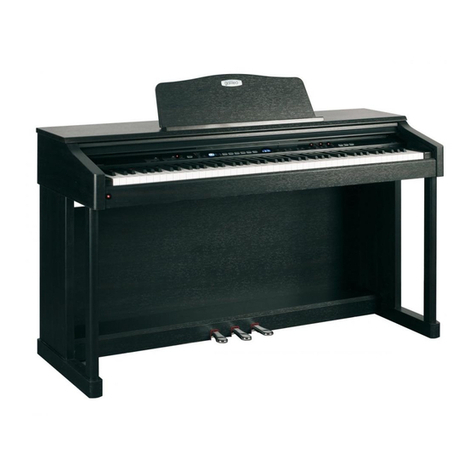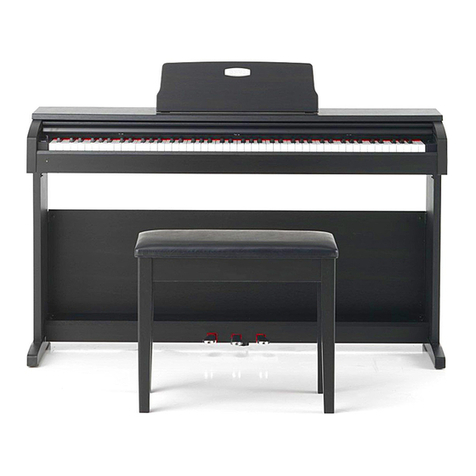
!
Contents
Introduction . . . . . . . . . . . . . . . . . . . . . . . . . . . . . . . . . . . . . . 3
Contents . . . . . . . . . . . . . . . . . . . . . . . . . . . . . . . . . . . . . . . . 5
Safety & Precautions . . . . . . . . . . . . . . . . . . . . . . . . . . . . . . . 6
Installation . . . . . . . . . . . . . . . . . . . . . . . . . . . . . . . . . . . . . . . 7
Power On (and Volume Controls) . . . . . . . . . . . . . . . . . . . . . 8
Instrument Functions . . . . . . . . . . . . . . . . . . . . . . . . . . . . . . 8
Voices . . . . . . . . . . . . . . . . . . . . . . . . . . . . . . . . . . . . 8
Touch . . . . . . . . . . . . . . . . . . . . . . . . . . . . . . . . . . . . . 8
Dual . . . . . . . . . . . . . . . . . . . . . . . . . . . . . . . . . . . . . . 9
Split . . . . . . . . . . . . . . . . . . . . . . . . . . . . . . . . . . . . . . 9
Rhythm Controls . . . . . . . . . . . . . . . . . . . . . . . . . . . . . . . . . . 10
Rhythm . . . . . . . . . . . . . . . . . . . . . . . . . . . . . . . . . . . . 10
Start . . . . . . . . . . . . . . . . . . . . . . . . . . . . . . . . . . . . . . 10
Fill-In . . . . . . . . . . . . . . . . . . . . . . . . . . . . . . . . . . . . . 10
Endings . . . . . . . . . . . . . . . . . . . . . . . . . . . . . . . . . . . . 10
Accompaniment Chords (A.B.C) . . . . . . . . . . . . . . . . . 11
Metronome . . . . . . . . . . . . . . . . . . . . . . . . . . . . . . . . . 11
Tempo . . . . . . . . . . . . . . . . . . . . . . . . . . . . . . . . . . . . . 11
Functions . . . . . . . . . . . . . . . . . . . . . . . . . . . . . . . . . . . . . . . . 11
Transpose . . . . . . . . . . . . . . . . . . . . . . . . . . . . . . . . . . 11
Octave . . . . . . . . . . . . . . . . . . . . . . . . . . . . . . . . . . . . . 12
Beat . . . . . . . . . . . . . . . . . . . . . . . . . . . . . . . . . . . . . . . 12
Chord Point . . . . . . . . . . . . . . . . . . . . . . . . . . . . . . . . . 12
Recording . . . . . . . . . . . . . . . . . . . . . . . . . . . . . . . . . . . . . . . . 12
Activating . . . . . . . . . . . . . . . . . . . . . . . . . . . . . . . . . . 12
Start . . . . . . . . . . . . . . . . . . . . . . . . . . . . . . . . . . . . . . 13
End . . . . . . . . . . . . . . . . . . . . . . . . . . . . . . . . . . 13
Playback . . . . . . . . . . . . . . . . . . . . . . . . . . . . . . . . . . 13
Demonstration Songs . . . . . . . . . . . . . . . . . . . . . . . . . . . . . . 12
Memory Settings . . . . . . . . . . . . . . . . . . . . . . . . . . . . . . . . . . 14
Saving To Memory . . . . . . . . . . . . . . . . . . . . . . . . . . . 14
Transferring To Memory . . . . . . . . . . . . . . . . . . . . . . . 14
External Connections . . . . . . . . . . . . . . . . . . . . . . . . . . . . . . . 15
Specifications . . . . . . . . . . . . . . . . . . . . . . . . . . . . . . . . . . . . . 16
Instrument Voice Chart . . . . . . . . . . . . . . . . . . . . . . . . . . . . . 17
Accompaniment Chart . . . . . . . . . . . . . . . . . . . . . . . . . . . . . . 19
Demo Song Chart . . . . . . . . . . . . . . . . . . . . . . . . . . . . . . . . . .20
Percussion Chart . . . . . . . . . . . . . . . . . . . . . . . . . . . . . . . . . . 22
Accompaniment Finger Chart . . . . . . . . . . . . . . . . . . . . . . . . 23






































